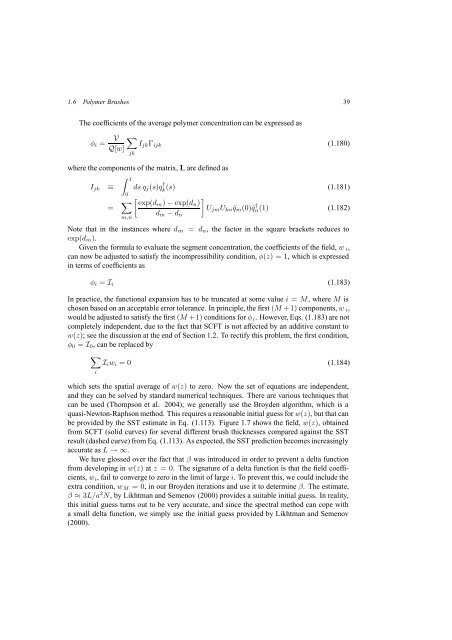Self-Consistent Field Theory and Its Applications by M. W. Matsen
Self-Consistent Field Theory and Its Applications by M. W. Matsen
Self-Consistent Field Theory and Its Applications by M. W. Matsen
Create successful ePaper yourself
Turn your PDF publications into a flip-book with our unique Google optimized e-Paper software.
1.6 Polymer Brushes 39<br />
The coefficients of the average polymer concentration can be expressed as<br />
φ i =<br />
V<br />
Q[w]<br />
∑<br />
I jk Γ ijk (1.180)<br />
jk<br />
where the components of the matrix, I, are defined as<br />
∫ 1<br />
I jk ≡ ds q j (s)q † k<br />
(s) (1.181)<br />
= ∑ 0<br />
[ ]<br />
exp(dm ) − exp(d n )<br />
U jm U kn¯q m (0)¯q n † (1)<br />
d<br />
m,n<br />
m − d n<br />
(1.182)<br />
Note that in the instances where d m = d n , the factor in the square brackets reduces to<br />
exp(d m ).<br />
Given the formula to evaluate the segment concentration, the coefficients of the field, w i ,<br />
can now be adjusted to satisfy the incompressibility condition, φ(z) =1, which is expressed<br />
in terms of coefficients as<br />
φ i = I i (1.183)<br />
In practice, the functional expansion has to be truncated at some value i = M, where M is<br />
chosen based on an acceptable error tolerance. In principle, the first (M +1)components, w i ,<br />
would be adjusted to satisfy the first (M +1)conditions for φ i . However, Eqs. (1.183) are not<br />
completely independent, due to the fact that SCFT is not affected <strong>by</strong> an additive constant to<br />
w(z); see the discussion at the end of Section 1.2. To rectify this problem, the first condition,<br />
φ 0 = I 0 , can be replaced <strong>by</strong><br />
∑<br />
I i w i =0 (1.184)<br />
i<br />
which sets the spatial average of w(z) to zero. Now the set of equations are independent,<br />
<strong>and</strong> they can be solved <strong>by</strong> st<strong>and</strong>ard numerical techniques. There are various techniques that<br />
can be used (Thompson et al. 2004); we generally use the Broyden algorithm, which is a<br />
quasi-Newton-Raphson method. This requires a reasonable initial guess for w(z), but that can<br />
be provided <strong>by</strong> the SST estimate in Eq. (1.113). Figure 1.7 shows the field, w(z), obtained<br />
from SCFT (solid curves) for several different brush thicknesses compared against the SST<br />
result (dashed curve) from Eq. (1.113). As expected, the SST prediction becomes increasingly<br />
accurate as L →∞.<br />
We have glossed over the fact that β was introduced in order to prevent a delta function<br />
from developing in w(z) at z =0. The signature of a delta function is that the field coefficients,<br />
w i , fail to converge to zero in the limit of large i. To prevent this, we could include the<br />
extra condition, w M =0, in our Broyden iterations <strong>and</strong> use it to determine β. The estimate,<br />
β ≈ 3L/a 2 N, <strong>by</strong> Likhtman <strong>and</strong> Semenov (2000) provides a suitable initial guess. In reality,<br />
this initial guess turns out to be very accurate, <strong>and</strong> since the spectral method can cope with<br />
a small delta function, we simply use the initial guess provided <strong>by</strong> Likhtman <strong>and</strong> Semenov<br />
(2000).
















